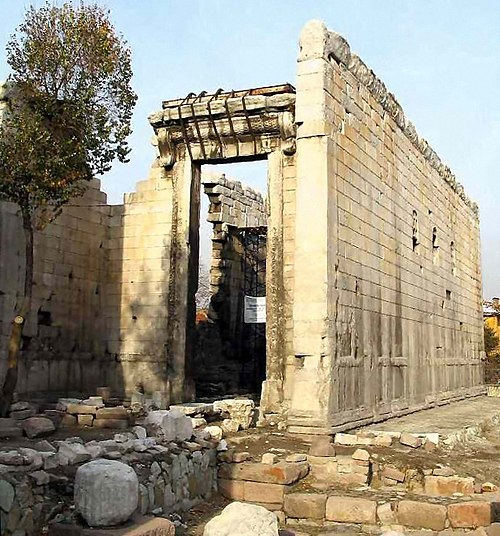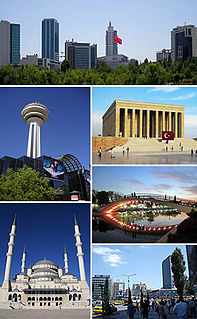
Ankara, historically known as Ancyra and Angora, is the capital of Turkey. With a population of 4,587,558 in the urban centre (2014) and 5,150,072 in its province (2015), it is Turkey's second largest city after Istanbul, having outranked İzmir in the 20th century. Ankara covers an area of 24,521 km2.

Galatia was an ancient area in the highlands of central Anatolia, roughly corresponding to the provinces of Ankara, Çorum, and Yozgat, in modern Turkey. Galatia was named after the Gauls from Thrace, who settled here and became its ruling caste in the 3rd century BC, following the Gallic invasion of the Balkans in 279 BC. It has been called the "Gallia" of the East, Roman writers calling its inhabitants Galli.

Res Gestae Divi Augusti is the funerary inscription of the first Roman emperor, Augustus, giving a first-person record of his life and accomplishments. The Res Gestae is especially significant because it gives an insight into the image Augustus portrayed to the Roman people. Various portions of the Res Gestae have been found in modern Turkey. The inscription itself is a monument to the establishment of the Julio-Claudian dynasty that was to follow Augustus.

Antioch in Pisidia – alternatively Antiochia in Pisidia or Pisidian Antioch and in Roman Empire, Latin: Antiochia Caesareia or Antiochia Colonia Caesarea – is a city in the Turkish Lakes Region, which is at the crossroads of the Mediterranean, Aegean and Central Anatolian regions, and formerly on the border of Pisidia and Phrygia, hence also known as Antiochia in Phrygia. The site lies approximately 1 km northeast of Yalvaç, the modern town of Isparta Province. The city is on a hill with its highest point of 1236 m in the north.

Ogier Ghiselin de Busbecq, sometimes Augier Ghislain de Busbecq, was a 16th-century Flemish writer, herbalist and diplomat in the employ of three generations of Austrian monarchs. He served as ambassador to the Ottoman Empire in Constantinople and in 1581 published a book about his time there, Itinera Constantinopolitanum et Amasianum, re-published in 1595 under the title of Turcicae epistolae or Turkish Letters. His letters also contain the only surviving word list of Crimean Gothic, a Germanic dialect spoken at the time in some isolated regions of Crimea.

The Temple of Caesar or Temple of Divus Iulius, also known as Temple of the Deified Julius Caesar, delubrum, heroon or Temple of the Comet Star, is an ancient structure in the Roman Forum of Rome, Italy, located near the Regia and the Temple of Vesta.

The Forum of Augustus is one of the Imperial forums of Rome, Italy, built by Augustus. It includes the Temple of Mars Ultor. The incomplete forum and its temple were inaugurated in 2 BC, 40 years after they were first vowed.
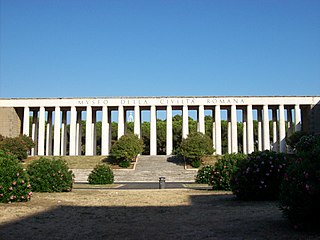
The Museum of the Roman Civilization is a museum in Rome, devoted to aspects of the Ancient Roman civilization.
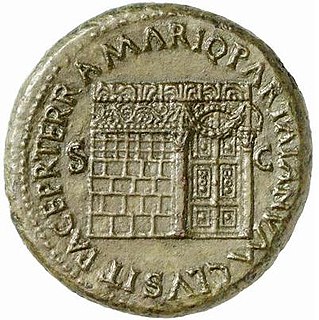
In ancient Rome, the main Temple of Janus as it is often called, although it was not a normal temple, stood in the Roman Forum near the Argiletum. It had doors on both ends, and inside was a statue of Janus, the two-faced god of boundaries. The doors were closed in times of peace and opened in times of war.
The history of Ankara can be traced back to the Bronze Age Hatti civilization, which was succeeded in the 2nd millennium BC by the Hittites, in the 10th century BC by the Phrygians, and later by the Lydians, Persians, Macedonians, Galatians, Romans, Byzantines, Seljuks, and Ottomans.

The Temple of Vespasian and Titus is located in Rome at the western end of the Roman Forum between the Temple of Concordia and the Temple of Saturn. It is dedicated to the deified Vespasian and his son, the deified Titus. It was begun by Titus in 79 after Vespasian's death and Titus's succession. Titus’ brother, Domitian, completed and dedicated the temple to Titus and Vespasian in approximately 87.
In epigraphy, a bilingual is an inscription that includes the same text in two languages. Bilinguals are important for the decipherment of ancient writing systems, and for the study of ancient languages with small or repetitive corpora.
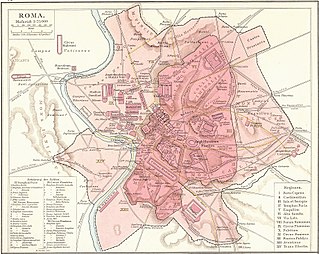
The Temple of Divus Augustus was a major temple originally built to commemorate the deified first Roman emperor, Augustus. It was built between the Palatine and Capitoline Hills, behind the Basilica Julia, on the site of the house that Augustus had inhabited before he entered public life in the mid-1st century BC. It is known from Roman coinage that the temple was originally built to an Ionic hexastyle design. However, its size, physical proportions and exact site are unknown. Provincial temples of Augustus, such as the much smaller Temple of Augustus in Pula, now in Croatia, had already been constructed during his lifetime. Probably because of popular resistance to the notion, he was not officially deified in Rome until after his death, when a temple at Nola in Campania, where he died, seems to have been begun. Subsequently, temples were dedicated to him all over the Roman Empire.
Numerous temples of Augustus, the first Roman emperor, were built in the territories of the Roman Empire; sixteen are known in Italia alone. They included the following:

The Temple of Augustus is a well-preserved Roman temple in the city of Pula, Croatia. Dedicated to the first Roman emperor, Augustus, it was probably built during the emperor's lifetime at some point between 27 BC and his death in AD 14. It was built on a podium with a tetrastyle prostyle porch of Corinthian columns and measures about 8 by 17.3 m, and 14 m (46 ft) high. The richly decorated frieze is similar to that of a somewhat larger and more recent temple, the Maison Carrée in Nîmes, France. These two temples are considered the two best complete Roman monuments outside Italy.

Artavasdes I of Media Atropatene, also known as Artavasdes I of Atropatene, Artavasdes I and Artavasdes was a Prince who served as a King of Media Atropatene. Artavasdes I was an enemy of King Artavasdes II of Armenia and his son Artaxias II. He was a contemporary with the Ptolemaic Greek Queen Cleopatra VII and Roman Triumvir Mark Antony, as Artavasdes I was mentioned in their diplomatic affairs.

Publius Sulpicius Quirinius was a Roman aristocrat. After the banishment of the ethnarch Herod Archelaus from the tetrarchy of Judea in AD 6, Quirinius was appointed legate governor of Syria, to which the province of Judaea had been added for the purpose of a census.
Three extensive underground collective burial columbaria at Vigna Codini were discovered in the mid-nineteenth century, near the Aurelian Walls between the via Appia and via Latina in Rome, Italy. Although this area on the outskirts of Rome was traditionally used for elite burials, these columbaria that emerged in the Augustan era seem to have been reserved for non-aristocratic individuals, including former slaves. Not to be confused with the later phenomenon of catacomb inhumations, these subterranean chambers contained niches for cremation urns. The columbaria at Vigna Codini are among some of the largest in Rome.

Mariana McCaulley was an epigrapher and Latin teacher.
Rex E. Wallace is an American linguist and classical scholar specializing in Etruscan language, languages of ancient Italy, epigraphy, historical linguistics. He served as Professor of Classics at University of Massachusetts Amherst from 1985 until his retirement in 2018.
